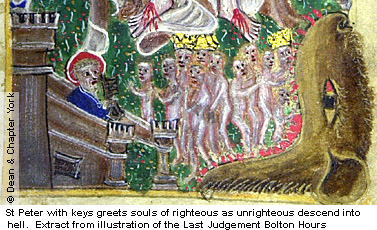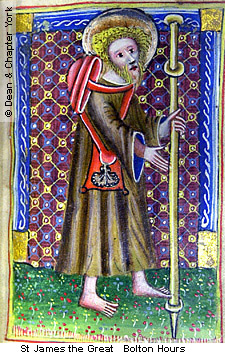
Patterns of Pilgrimage in England c.1100-c.1500

Introduction
Scale of Perfection
There is no need to run to Rome or Jerusalem to look for [Jesus] there, but turn your thought into your own soul where he is hidden.
Walter Hilton, Scale of Perfection, Book I.49, 5
The medieval experience of pilgrimage in all its forms was strongly influenced by the early history of the Church. From the fourth century CE onwards, multiple interpretations of the pilgrimage motif co-existed within Christianity (see Early Christian Tradition). First and foremost was the key theological concept, derived from the New Testament (see The Bible), which viewed the Christian life as a journey towards the heavenly Jerusalem. There were, however, also three principal strands of practical interpretation through which this concept could be acted out in the lives of individuals:

- Moral Pilgrimage, which is worked out in a life of daily obedience to God in the place of each person's everyday calling. It largely corresponds to the Active Life.
- Interior Pilgrimage, which roughly corresponds to the Contemplative Life and can be expressed through monasticism, anchoritism, meditation and mysticism. It stresses stability of purpose and location and the priority of seeking an 'interior Jerusalem', the presence of God within the individual soul.
- Place Pilgrimage, which includes journeying to saints' shrines or other holy places to learn, to express devotion and to gain (for oneself or for others) forgiveness for specific sins, general indulgences, healing and other benefits. Ideally the journey would encourage inner spiritual growth and often included the acquisition of pilgrim badges and relics which allowed pilgrims to transfer their experiences to their home environments. Pilgrimage offered a chance to escape from the responsibilities and constraints of the home community. It often resulted in increased status within the community on the pilgrim's return.
This multi-faceted view of pilgrimage formed an important part of the spiritual inheritance of the medieval Church, with each strand of interpretation representing a particular kind of spiritual journey with different priorities, practices and even goals. The distinctive character of these strands reveals the rich variety of ways in which pilgrimage was understood and the extent to which the pilgrimage motif permeated religious culture and experience.
'Stability' and 'Mobility': tensions and questions
The most enduring and significant problem in reconciling different expressions of the pilgrimage motif stemmed from the deeply-rooted tension between the ideals of 'stability' and 'mobility' which can be seen through the history of the Christian Church. The concepts of a daily life of service within the community and of the monastic and anchoritic vocations all relied on stability, commitment to a particular location and purpose. Pilgrimage to holy places, on the other hand was essentially about mobility, removing men and women from their normal context and sometimes raising suspicions of irresponsibility, instability and immorality. From the early centuries of the Church, there had been criticism of such journeys from those who regarded them as unnecessary distractions, wasteful of time and resources, and liable to expose participants to physical and moral dangers. In theory, pilgrimage to holy places could both reflect and strengthen the life pilgrimage of an individual; in practice it was often seen as a distraction or a substitute for real devotion. The out-workings of these innate tensions can be observed in medieval history, spirituality and literature and prompted ongoing debate and dissension up to and beyond the Reformation (see The Reformation).
Dee Dyas



